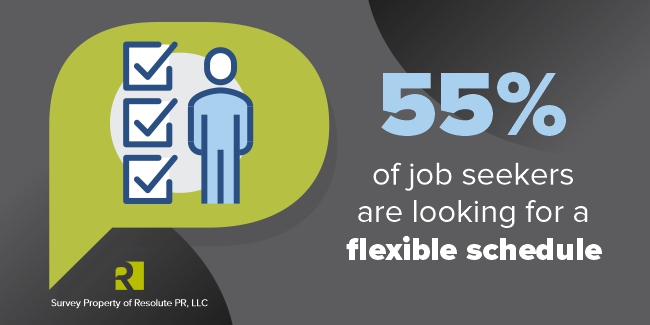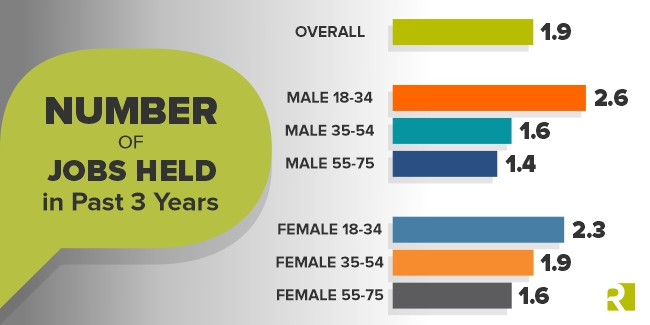Things change, and workplace “norms” are no exception. Companies are scrambling to navigate the changing workforce, especially to successfully attract and retain employees. What was once strictly an HR function has evolved into a marketing issue. Long gone are the days of working a single job for one company for your entire career, and organizations have to be competitive to stand out. So, how do you recruit and retain a talented workforce?
As part of Resolute’s workforce study, we uncovered a few trends and data points that help explain the changes we’re seeing in today’s workforce. While each workplace is different, it’s critical to understand how these key shifts are making waves in workplace behavior nationwide.
These shifts in work behavior have not only reshaped the way people do their jobs, but they have also prompted companies to reconsider their approach to talent management, employee engagement, workforce recruitment and human resource policies. While some changes were driven by necessity due to the pandemic (yes, we’re still talkin’ COVID-19), many are likely to impact the future of work.
1. Multiple jobholding
First, we have multiple jobholding. Multiple jobholding is when someone works more than one job at the same time. From 1996-2018, the U.S. census reported the multiple jobholding rate averaged at 7.2%. However, our research shows this number has doubled, with 14% of respondents sharing they work more than one job.
This can be working for more than one employer, having multiple “side hustles” or even participating in a “gig economy.” This means you have a second (or third) job that’s temporary or part-time, such as rideshare driving or grocery delivery. Some industries, such as retail and construction, rely heavily on part-time, seasonal or contract work. In these cases, individuals don’t have a choice but to frequently switch jobs as contracts expire or new opportunities arise.
Because we know many employees are working more than one job to help ends meet, managers can take these internal communications steps to support their employees and ensure they experience a positive work environment.
- Open communication goes a long way. Create an open and supportive environment where employees feel comfortable discussing their multiple job situations.
- Encourage employees to communicate with their managers about availability, scheduling and any other challenges they may face.
- If you aren’t already, offer opportunities for career development and advancement within your company. This can motivate employees to focus on one job that offers the most growth potential.
Equally important to retaining current employees is highlighting that these benefits can help attract new talent. By making scheduling easy, promoting ease of work in hiring materials, and showcasing growth opportunities up front, employers can show dedication to make it easier for the applicant to hold multiple jobs. Plus, if the benefits and growth opportunities are significant enough, we can even encourage a shift of focus on one job.
2. Type of work desired
It’s no secret that younger generations value both a greater work-life balance and remote work opportunities. We know the COVID-19 pandemic accelerated the acceptance of remote work across industries and generations. Many companies didn’t have a choice. They had to go virtual to survive, and it impacted a changing workforce.
However, it’s not just Millennials or Gen Z. Our research found that job seekers want less human interfacing jobs, especially those who are currently working face-to-face jobs. Remote work often allows for a more flexible schedule, which can be especially appealing to those who need to balance work with personal commitments.

Also, holding a remote job saves workers both time and money (for businesses and employees alike). With a high rise in gas prices across the country, working from home helps avoid daily commutes, leading to less stress when paying at the pump and more free time. Job seekers may be looking for remote or hybrid positions to save money on transportation, work attire and meals, which contributes to improved financial well-being.
On a similar note, people doing the most computer work would like more of that in their desired job mix. Of all work options provided, our data showed that the most preferred type was office, management and farming work.
3. Economic factors that impact hiring
Attracting and retaining employees is crucial for the growth of any business or brand, especially in a changing workforce. Promoting competitive salaries, benefits, and additional perks may require a financial commitment, which could vary depending on the state of the economy. Ultimately, this investment can actually result in increased profitability.
Do you know someone who has an older child living at home? Of men under the age of 35 who are working full-time, 41% are living with their parents. If working part-time, that stat rises to 53%. With the cost of living on the rise, housing expenses, such as rent or mortgage payments and grocery bills, are a significant portion of budgets. It’s ultimately cheaper to live at home, especially while working part time.
It’s not that people are flat out choosing NOT to work. In fact, our research shows those who are working full time indicated being twice as satisfied with life as those who are unemployed.
Additionally, we found that those who are both employed and unemployed report their household monetary situations have become worse over the last 12 months. Knowing this, job seekers are inclined to consider opportunities that offer financial security. It’s important for hiring managers to show empathy and understanding to new and current employees’ situations.
Not every company will be able to offer the most competitive compensation and benefit packages, especially during an economic downturn. If that’s not feasible, we recommend these free or low-cost ways to build trust with potential employees.
- First, streamline your recruitment process and provide timely feedback to candidates. Not leaving them hanging in the dust can leave a positive impression – even if they don’t get the job.
- Second, highlight how the roles you’re hiring for can position candidates for growth and advancement once the economy recovers. This could be anything from community networking opportunities to allowing time for skill development through free or low-cost certifications or training webinars.
- Share testimonials or stories. For example, these could be from current employees who have experienced growth and positive experiences with your company.
- Lastly, you could pull customer testimonials, showcasing why this job matters and, if applicable, how it aligns with your company values.
4. A generational change in workforce habits
According to LinkedIn data, another indication of a changing workforce is that members of Gen Z were switching jobs at a rate 134% higher in 2020 than in 2019. Our research supports this, as job holders averaged having two different jobs in past three years. In fact, men ages 18-34 held nearly three different jobs in the past three years. This generational shift in work isn’t too surprising. Younger generations often have different priorities and values when applying for jobs compared to more seasoned generations.

Apart from compensation, people switch jobs mainly because they want work that’s meaningful, matches their values and offers opportunities for career growth. Additionally, these job seekers site poor or outdated policies as reasons for leaving a job. When an individual is not happy with the culture, work environment, or values of their current company, that’s an easy reason to quit. They’ll most likely be swayed by workforce recruitment marketing tactics and be more likely to switch to an organization that aligns better with their personal and professional values.
Poor working conditions, such as bad management, excessive stress, or lack of support, can prompt employees to look for healthier and more supportive workplaces. Processes such as exit interviews or anonymous surveys can help managers identify these pain points and provide a final opportunity for transparent communication. Once recognized, the next step is to look for ways to provide a more positive employment experience.
The era has long passed when individuals used to engage in the traditional practice of dedicating their entire careers to a singular job within a single company. In light of this transformation, it’s incredibly important for hiring managers to keep up-to-date on the dynamic shifts and evolutions within the changing workforce. Doing so allows businesses to develop strategies to recruit and retain talented employees.
